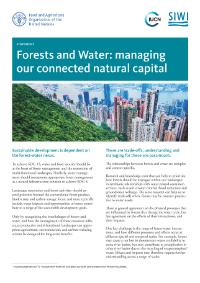Resource information
The forest-water nexus is crucial for ensuring water and food security, as well as for achieving sustainable development objectives. Only by recognising the interlinkages of forests and water, and how the management of these resources influences productive multi-functional landscapes can appropriate long-term benefits from landscape planning and management be actualized. And while it is important that generalized assumptions about the forest-water nexus are not widely applied due to their complex and context specific nature, the knowledge is available to lend guidance. Ultimately, we must facilitate cross-sectoral engagement to improve our ability to design, implement, and learn from landscape approaches that both rely on the relationships between forests and water, and impact them. This is necessary if all countries are to achieve the Sustainable Development Goals, in particular those related to hunger (SDG 2), poverty (SDG 1), water (SDG 6), climate (SDG 13), energy (SDG 7), economic growth (SDG 8), sustainable cities (SDG 11) and life on land (SDG 15).
In August 2017, parallel to World Water Week, the Food and Agriculture Organization (FAO), the International Union for the Conservation of Nature (IUCN) and the Stockholm International Water Institute (SIWI) hosted a meeting with 12 experts from the forest and water sectors. The meeting aimed to establish consensus on (i) issues and messages, (ii) develop key communication messages and strategies; and, (iii) develop joint activities for 2018-19 that promote the forest-water nexus. The successful meeting concluded by producing a joint statement on forests and water.

